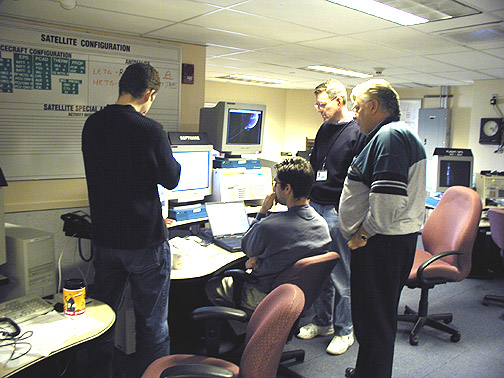 |
| FIGURE 22: False color image of comet Tempel-Tuttle taken on February 19, 1998 Credit: Lowell Observatory |
January 12, 2004: From ghoulies and ghosties
And long-leggedy
beasties
And things that go bump in the night,
Good Lord, deliver us!
Traditional Scottish Prayer
Every year in mid-November the Earth passes through a stream of rocks, dust grains, and gas that trails behind Comet Temple-Tuttle. When tiny fragments of this cometary debris encounter the Earth's atmosphere, they burn up, creating brief streaks of light popularly called "shooting stars", or more accurately, meteors. The meteor shower that occurs during this passage is called the Leonid meteor shower, because the meteors appear to come from the constellation Leo. The opportunity to observe what can be a spectacular celestial light show keeps astronomy buffs up into the wee hours of the morning for a few nights this time of year. It also keeps the Chandra Flight Operations personnel awake, worrying about meteors traveling 150 thousand miles per hour that could go bump in the night and damage the multibillion dollar space observatory.
They do more than just worry. During the passage through four shower streams on November 13, 18, 19 and 23, 2003, Flight Ops pointed Chandra away from the incoming meteors and tilted the solar arrays to minimize the chance of a hit on the sensitive back side of the solar panels.
Still, as the saying goes, stuff happens. While assessing the telemetry data, Sabina Bucher, the Chandra Pointing Control and Attitude Determination (PCAD) Engineer, noticed odd behavior on the pointing stability daily plot for early Saturday morning, November 15. She alerted Dan Shropshire, head of Flight Ops Engineering, who in turn contacted Roger Brissenden, Flight Director for the Chandra X-ray Observatory. "The first thing I wanted to know," said Shropshire, "was whether this was a system-wide problem. I asked for an end to end check of all subsystem telemetry to ensure that no other satellite issues were seen. To our great relief, everything checked out okay."
Although the Flight Ops team cannot say with 100% certainty that the spacecraft was hit by a meteor, the lack of any evidence of spurious thruster firings or other indications of an internal cause means that something caused the Chandra spacecraft to wobble slightly. The only plausible explanation is an impact with a Leonid meteor about the size of a grain of sand. "The fact that we were in a heightened meteor environment - the annual Leonid meteor shower - and a preliminary analysis of direction and magnitude of possible impact, lends credence to this theory," said Shropshire.
 |
| FIGURE 22: False color image of comet Tempel-Tuttle taken on February 19, 1998 Credit: Lowell Observatory |
The probability of Chandra being hit by a meteorite with a mass greater than about 1 microgram during a large meteor shower has been estimated at one in 10,000, if the spacecraft is directly in the line of the meteors. Given that Chandra was pointed slightly away from the direct line, and that the meteors were coming at a relatively low rate, Shropshire estimates that the probability of such an event at the time it occurred was about one in a million. "We often talk about events which are one-in-a-million, such as winning the lottery, but you never actually believe it will happen," said Shropshire. "To be honest, I would have much rather had won the lottery! It certainly proves that it is good to prepare for the worst in cases such as these, where the stakes are so high."
As of this writing, Flight Ops is still investigating the possible consequences of the event. They are currently examining all of Chandra's backup, and rarely used, systems to ensure that they were not damaged. This activity will take a few more weeks to complete.
 |
| FIGURE 23: Chandra & Leonids 2001 Willard Simmons, Dan Shropshire, Roger Brissenden & Leon McKendrick of Flight Ops Team. Credit: CXC |
Wallace and Karen Tucker
References
For a detailed look at this subject, see Chandra Newsletter
#9:
http://cxc.harvard.edu/news_09/node18.html
Scottish prayer is from
collection by D. L. Ashliman , 1997
http://www.pitt.edu/~dash/bump.html#prayer